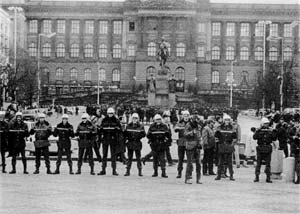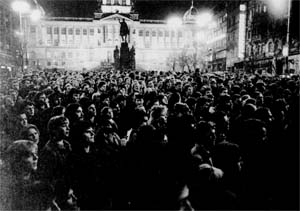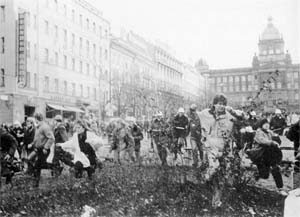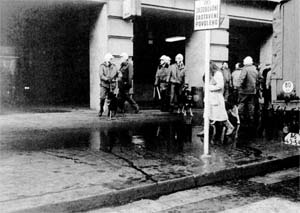 |
Prague January 1989 (CSDS collection) |
Washington, D.C., January 26, 2009 - The brutal suppression by Czechoslovak Communist authorities of commemorative ceremonies for "Palach Week" 20 years ago this month marked the beginning of the end of the regime in the annus mirabilis 1989, according to secret police, Communist Party, and dissident documents posted today on the Web by the Czechoslovak Documentation Centre (Prague) and the National Security Archive (www.nsarchive.org) at George Washington University (Washington, D.C.).
Various independent civic initiatives (also known in the official Communist press as "anti-state" and "anti-socialist forces") had planned to lay wreaths at the site in Prague's main Wenceslas Square where the student Jan Palach in January 1969 had burned himself to death in protest against the repression that followed the Soviet occupation of Czechoslovakia in August 1968. Also planned was a pilgrimage to the rural cemetery where Palach's ashes were interred.
But the Communist secret police cracked down with beatings, tear gas, and mass arrests, including the dissident playwright and future Czechoslovak president Václav Havel. The repression occurred at the exact moment in January 1989 that the signatory countries to the Helsinki Final Act (the Conference on Security and Cooperation in Europe, or CSCE) were meeting in Vienna, and drew widespread protests from abroad, including from U.S. Secretary of State George Shultz, leading Soviet dissident Andrei Sakharov, and perhaps most eloquently, American playwright Arthur Miller.
Today's Web posting includes never-before-published documents from Czechoslovak archives, including the secret police reports on the demonstrations in January 1989 and the internal Communist Party briefings and instructions (the Party line) to cadres about the events of January. Also included are key Charter 77 and other dissident and samizdat statements, and several international protests of the time.
The posting republishes the detailed chronology of events in January and February 1989, originally written by the Czechoslovak Documentation Centre for its quarterly publication Acta (Vol. 3, No. 9-12), compiled and edited by Jan Vladislav in collaboration with Vilém Prečan, titled "Czechoslovakia: Heat in January 1989" and ultimately printed in December 1989 just as the "velvet revolution" toppled the Communist regime and put former prisoner Havel in the presidential office in Prague Castle.
Leading the posting is Professor Vilém Prečan's essay "Palach's Legacy: An Appeal to Czechoslovaks in the 1989 Struggle for Freedom." The final section of the posting includes the digital image of an original letter from Palach himself in 1969, urging the occupation of Radio Prague and a call for a general strike. Only days later, he burned himself to death.
"These documents posted on the Web today are the Internet equivalent of the wreath that Václav Havel tried to place in Wenceslas Square in January 1989," remarked Thomas Blanton, director of the National Security Archive at George Washington University. "We don't face arrest like he did for this commemoration, but we do have the responsibility of never forgetting those sacrifices, both by Jan Palach, and by everyone who made the peaceful revolutions of 1989."
Section 1: The Meaning of "Palach Week"
 |
Prague January 1989 (CSDS collection) |
Essay. January 2009, Prague – Vilém Prečan, "Palach's Legacy: An Appeal to Czechoslovaks in the 1989 Struggle for Freedom"
Translation by Derek Paton.
Document 1. January 10, 1989, Prague – Statement by the Movement for Civil Liberties: Jan Palach's Challenge
CSDS Prague, Palach Week Collection.
Translation by Alice and Gerald Turner (pseudonym "A. G. Brain"), published in Acta, Document 4.
Document 2. February 5, 1989, Prague – Ludvik Vaculik: Communism is best-ial
Libri prohibiti, Prague, Ludvik Vaculik Collection.
Translation by Alice and Gerald Turner (pseudonym "A. G. Brain"), published in Acta, Document 55.
Document 3. February 16, 1989, Prague – Statement by the Movement for Civil Liberties: Paths to democracy in the wake of the January events
CSDS Prague, Palach Week Collection.
Translation by Alice and Gerald Turner (pseudonym "A. G. Brain"), published in Acta, Document 61.
Section 2: Primary Sources on "Palach Week" January 1989
 |
Prague January 1989 (CSDS collection) |
Document 4. January 1989, Prague – A flyer in which five independent initiatives invite citizens to participate on January 15 in a Jan Palach memorial in Prague, as well as a January 21 pilgrimage to his grave in the village of Všetaty (30 km north of Prague).
CSDS Prague, Palach Week Collection.
Translation by Todd Hammond.
Document 5. January 16, 1989. Prague – Internal information (No. 53) on the events of January 13 to 15, 1989, provided by the Communist Party (CPCz) to Presidium members and candidates and to CPCz Central Committee secretaries. The briefing gives times and places of the various "unauthorized assemblies" and detentions, the number of security forces (2200 from the SNB and 1300 from the Peoples' Militia), the recommendation that the militia be equipped with batons for next time and that security "prepare a closed-off area into which the crowd will be pushed…."
National Archive Prague, ÚV KSČ (CPCz CC), Documentation, 1989.
Translation by Todd Hammond.
Document 6. January 17, 1989, Prague – The Charter 77 statement addressed to the governments participating in the CSCE, then meeting in Vienna. The Charter statement says "only time will tell" if "the signing by 35 states of a document whose clauses some of them neither observe nor have any obvious intention of doing so, will nevertheless help to stimulate an improvement in the human rights situation," and points out that those arrested during the Palach Week memorials were in custody "not for planting bombs, but for laying flowers."
CSDS Prague, Charter 77 Collection.
Translation by Alice and Gerald Turner (pseudonym "A. G. Brain"), published in Acta, Document 21.
Document 7. January 17, 1989, Vienna – Speech and press conference by U.S. Secretary of State George Shultz at the conclusion of the CSCE meetings, including his denunciation of the Czechoslovak authorities for their repression of the Palach Week commemorations with "rubber truncheons, tear gas, and water cannons" "in direct violation of the commitments just solemnly given by the Government of Czechoslovakia."
U.S. Department of State Bulletin, March 1989, pp. 50-54.
Document 8. January 17, 1989. Prague – Internal Party information (No. 54)on the events of January 16, 1989 on Wenceslas Square, Prague, provided to CPCz Presidium members and candidates and to CPCz Central Committee secretaries. This briefing describes the arrests of Havel and other Charter 77 representatives "whose bouquets were confiscated by the officers present." Attached is an appendix to the previous Internal Party information 53, listing individuals who received medical treatment (for injuries including bone fractures, concussion, and shoulder dislocation) after the repression of the January 15 "anti-social events."
National Archive Prague, ÚV KSČ (CPCz CC), Documentation, 1989.
Translation by Todd Hammond.
Document 9. January 18, 1989, Prague – Internal Party information (No. 55) on the events of January 17, 1989, as provided to CPCz Presidium members and candidates and to CPCz Central Committee secretaries. The briefing reports that the "so-called independent initiatives" continued "to intensify the pressure on the state organs," which had to clear Wenceslas Square twice on that day. The Party line is that the security forces used only "moderate measures," but also of course water cannons.
National Archive Prague, ÚV KSČ (CPCz CC), Documentation, 1989.
Translation by Todd Hammond.
Document 10. January 19, 1989, Prague – Internal Party information (No. 56) on the events of January 18, 1989 in Prague, provided to CPCz Presidium members and candidates and to CPCz Central Committee secretaries. The briefing notes that both American and British diplomats are among the crowd, "a provocational assembly of anti-socialist elements" that numbered at least 1,000 at the statue of St. Wenceslas, plus "around 2000 spectators." Instead of attacking as on previous days, the security forces "remained hidden at their readiness and reserve locations and prepared for immediate commitment" but did not intervene.
National Archive Prague, ÚV KSČ (CPCz CC), Documentation, 1989.
Translation by Todd Hammond.
 |
Prague January 1989 (CSDS collection) |
Document 11. January 19, 1989, Prague – Eyewitness accounts of the January 19th demonstration and repression, compiled from reports telephoned to Radio Free Europe. Witnesses describe the police attacks as the "most brutal" of the week, and note the relative restraint of the uniformed SNB police compared to the riot police units, also called the "strong-arm squad" or "Jakeš' smurfs."
CSDS Prague, Palach Week Collection.
Translation by Alice and Gerald Turner (pseudonym "A. G. Brain"), published in Acta, Document 29.
Document 12. January 22, 1989, Prague – The head of the State Security Karel Vykypěl provides a concise report to the Minister of the Interior František Kincl on the Palach memorials and "provocational assemblies" between January 15 and 21, 1989. The report states that these events "clearly displayed the mounting aggressiveness of the adversarial community" and blames the "signatories of Charter 77 and the other so-called independent initiatives."
ABS (Archive of Security Units) Prague, A 34/1-1497, MBO Jan Palach 1989.
Translation by Todd Hammond.
Document 13. January 24, 1989, Prague – The CC CPCz Secretary General expresses thanks to the members of the People's Militia for their participation in suppressing the demonstrations, and assures them that the "decisions…taken by the organs of the party and state… for the maintenance of security and order in the center of the capital city… have been accepted with full understanding" by "the absolute majority of our population."
National Archive Prague, ÚV KSČ, Miloš Jakeš Office, 1989.
Translation by Todd Hammond.
Document 14. January 25, 1989, Prague – Memorandum of the Government of the Czech Socialist Republic on the events in Prague of January 15 to 21, 1989. The government formally states its support for "the decisive measures taken by the security units" and declares "that the vast majority of our citizens condemns" the Palach memorials and gatherings.
National Archive Prague, ÚPV ČSSR (Office of the ČSSR Government), Memoranda and decisions of Government sessions, 1989.
Translation by Todd Hammond.
Document 15. January 25, 1989, Prague – The Minister of the Interior František Kincl provides Prime Minister Ladislav Adamec with a detailed report “on the anti-social activities of anti-socialist elements on January 15-22, 1989, in Prague and in Všetaty… and on the security measures taken to secure calm and public order.” The report includes specific details on the demonstrations and repressions of January 19, including crowd estimates (on the low side) of 2500 persons who “fled toward the lower part of the square” after “security units intervened” at 17:15, but “were prevented in this by a coordinated intervention by the People’s Militia.” The report also describes the repression of the Všetaty pilgrimage on January 21, including the presence of foreign diplomats from the U.S., Canada, Great Britain, and Denmark. On January 21, the report states, “449 persons were identity checked,” “227 persons were sent back,” and “another 222 persons who refused to change their minds about continuing to Všetaty were taken for questioning.”
National Archive Prague, ÚPV ČSSR (Office of the ČSSR Government), Memoranda and decisions of Government sessions, 1989.
Translation by Todd Hammond.
Document 16. January 29, 1989, Roxbury, USA – Arthur Miller denounces the imprisonment of Václav Havel, and describes his arrest as "simply an attempt to call back the smoke that Palach sent billowing into the sky."
CSDS Prague, Václav Havel Collection, Box 13.
Published in the samizdat journal Lidové noviny, under the title "Where is the future?" and subsequently in Acta, Document 48.
Document 17. January 29, 1989. Moscow – Noted Soviet dissidents Yelena Bonner, Andrei Sakharov, and others send a message to the heads of states participating in the CSCE, describing the repression in Prague as a "blatant violation of the Vienna accords."
CSDS Prague, Palach Week Collection.
Translation by Alice and Gerald Turner (pseudonym "A. G. Brain"), published in Acta, Document 47.
Document 18. February 21, 1989. Prague – Václav Havel's final statement as defendant at the Prague 1 District Court. Havel dissects the indictment's use of the words "anti-state" and "anti-socialist" as "no more than a derogatory label for all citizens who inconvenience the regime for whatever reason…."
CSDS Prague, Václav Havel Collection, Box 13.
Translation by Alice and Gerald Turner (pseudonym "A. G. Brain"), published in Acta, Document 66.
Section 3: Documentation from 1969
Document 19. [January 6, 1969, Prague.] – Jan Palach, in a letter to the student leader Lubomír Holeček, proposes a student occupation of Prague Radio and the broadcast of a call for a general strike.
ABS (Archive of Security Units) Prague, H-682/1. Fascimile in Petr Blažek, Patrik Eichler, Jakub Jareš et al.: Jan Palach ´69. Prague: Togga, FF UK, and ÚSTR, 2009, pp. 600–602.
Translation by Todd Hammond.
Document 20. January 21, 1969, Washington D.C. – The Central Intelligence Bulletin of the CIA, circulated to top U.S. government officials on the day after the inauguration of new president Richard Nixon, reports that "[t]housands of disaffected youths yesterday marched in the streets in memory of Jan Paluch [sic], a 21-year-old student whose self-immolation has aroused the entire population" of Czechoslovakia.
National Archives & Records Administration (College Park, Maryland), CIA CREST Database.
Document 21. January 21, 1969, Washington D.C. – The top National Security Council staff person for Eastern European matters, Helmut Sonnenfeldt, informs national security adviser Henry Kissinger: "the regime will have to decide whether to attempt to master the situation by itself or to let the Soviets do it. It will probably prefer the former course to minimize brutality, even at the risk of thereby making itself a Soviet tool."
U.S. Department of State, Foreign Relations of the United States series, 1969-1976, Volume XXIX, pp. 203-204.
Document 22. February 3, 1969, Prague – The U.S. Embassy cables Washington with an assessment of the "growing assertiveness of conservatives and ‘realists' in wake of emotional upsurge evoked by Palach suicide" and remarks that the "Palach self-immolation was major setback for hardliners, arresting trend toward public apathy on which they count."
U.S. Department of State, Foreign Relations of the United States series, 1969-1976, Volume XXIX, pp. 204-206.
Document 23. February 26, 1969, Washington D.C. – The Central Intelligence Bulletin of the CIA reports that the latest "suicide-by-fire in Prague's Wenceslas Square" [by 19-year-old student Jan Zajic] "is not likely to generate widespread public disturbance or precipitate a political crisis as did the Palach affair in mid-January" because "the population has become more or less inured to such incidents by over 30 self-immolation attempts."
National Archives & Records Administration (College Park, Maryland), CIA CREST Database.
Section 4: The chronology of January – February 1989
The chronology of the events of January and February 1989 before and after the "Palach Week," written by the Czechoslovak Documentation Centre for its quarterly publication Acta, in Vol. 3, No. 9-12, Winter 1989, compiled and edited by Jan Vladislav in collaboration with Vilém Prečan, titled "Czechoslovakia: Heat in January 1989" and ultimately printed in December 1989.

